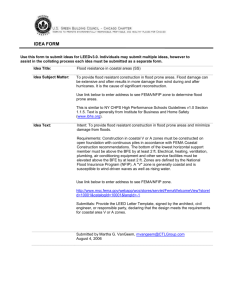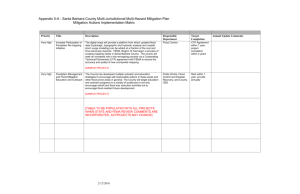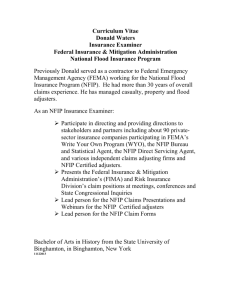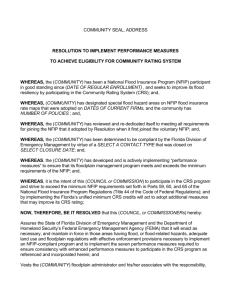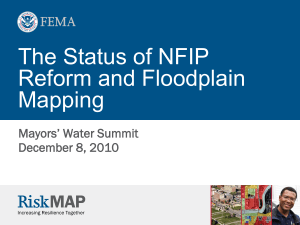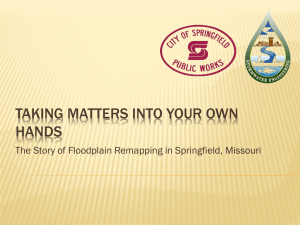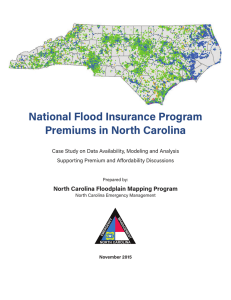NFIPmemo
advertisement
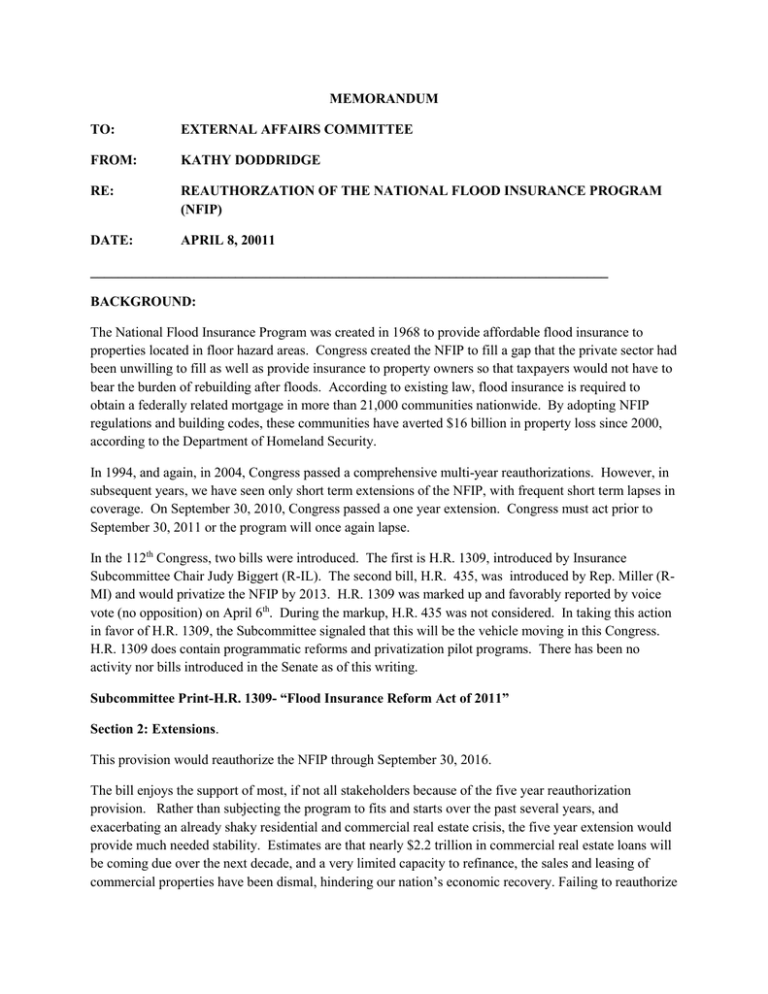
MEMORANDUM TO: EXTERNAL AFFAIRS COMMITTEE FROM: KATHY DODDRIDGE RE: REAUTHORZATION OF THE NATIONAL FLOOD INSURANCE PROGRAM (NFIP) DATE: APRIL 8, 20011 ___________________________________________________________________________ BACKGROUND: The National Flood Insurance Program was created in 1968 to provide affordable flood insurance to properties located in floor hazard areas. Congress created the NFIP to fill a gap that the private sector had been unwilling to fill as well as provide insurance to property owners so that taxpayers would not have to bear the burden of rebuilding after floods. According to existing law, flood insurance is required to obtain a federally related mortgage in more than 21,000 communities nationwide. By adopting NFIP regulations and building codes, these communities have averted $16 billion in property loss since 2000, according to the Department of Homeland Security. In 1994, and again, in 2004, Congress passed a comprehensive multi-year reauthorizations. However, in subsequent years, we have seen only short term extensions of the NFIP, with frequent short term lapses in coverage. On September 30, 2010, Congress passed a one year extension. Congress must act prior to September 30, 2011 or the program will once again lapse. In the 112th Congress, two bills were introduced. The first is H.R. 1309, introduced by Insurance Subcommittee Chair Judy Biggert (R-IL). The second bill, H.R. 435, was introduced by Rep. Miller (RMI) and would privatize the NFIP by 2013. H.R. 1309 was marked up and favorably reported by voice vote (no opposition) on April 6th. During the markup, H.R. 435 was not considered. In taking this action in favor of H.R. 1309, the Subcommittee signaled that this will be the vehicle moving in this Congress. H.R. 1309 does contain programmatic reforms and privatization pilot programs. There has been no activity nor bills introduced in the Senate as of this writing. Subcommittee Print-H.R. 1309- “Flood Insurance Reform Act of 2011” Section 2: Extensions. This provision would reauthorize the NFIP through September 30, 2016. The bill enjoys the support of most, if not all stakeholders because of the five year reauthorization provision. Rather than subjecting the program to fits and starts over the past several years, and exacerbating an already shaky residential and commercial real estate crisis, the five year extension would provide much needed stability. Estimates are that nearly $2.2 trillion in commercial real estate loans will be coming due over the next decade, and a very limited capacity to refinance, the sales and leasing of commercial properties have been dismal, hindering our nation’s economic recovery. Failing to reauthorize the NFIP long-term not only exacerbates the market uncertainties but also could leave many commercial property owners, many of whom are struggling to stay afloat due to high vacancy rates and lower net operating incomes, without access to affordable flood insurance. The lack of available, affordable flood insurance for property owners, in many cases, would hold up the sale of commercial properties, further contributing to the economic crisis. Section 3: Mandatory Purchase. These provisions would authorize FEMA to suspend for 12 months (and extend for up to two more 12month periods) the federal mandate to purchase flood insurance in communities that are newly included in the 100-year floodplain. To be eligible, these communities must be: * In an area where there has been no history of flooding; * In the process of appealing a new floodplain map (where the insurance is required); or * Making progress toward improving a flood protection system, such as a levee or dam. The federal mandate to purchase flood insurance would not apply to the aforementioned circumstances, but the language explicitly provides the lender or servicer discretion to itself require flood insurance to obtain a loan. It would also terminate and refund ―force placed insurance (i.e., insurance that is bought and placed by the lender and imposed on the borrower to pay). Section 4: Reforms of Coverage Terms. These provisions would: * Set a minimum annual deductible both for properties paying a subsidized premium rate and those paying the full risk (actuarial) rate; * Index coverage limits annually based on the previous year’s inflation beginning in 2012; * Provide optional coverage for loss of use of the residence or business interruption at the full-risk rate if there is not a market for the coverage and it will not lead to additional borrowing; and * Provide for residential rate increases/fees to be paid in quarterly installments. This provision expands coverage to encourage participation in the NFIP. Increasing participation will lead to increased funds for the NFIP, help property owners recover from flood losses and decrease future federal assistance when under-insured properties flood and suffer loss. Adding options for living expenses, basement improvements, and the replacement cost of contents would also help increase protection for home- and small-business owners. Increasing the coverage limits, which have not been adjusted despite inflation since 1994, would more accurately reflect increases in property and contents values and provide fuller coverage to policyholders. Setting minimum deductibles to improve the long- term solvency of the financial program is reasonable. Allowing residents to pay in installments could help with the affordability of rate increase under the NFIP. Section 5. Reforms of Premium Rates. These provisions would: * Authorize an annual premium increase of up to a maximum of 20% per year. * Phase-in the full-risk rate for properties newly mapped into the 100 year floodplain. The rate would increase by 50% in the initial year and by 20% each year thereafter until the full-risk rate is reached. * Phases-in the full rate (by 20% a year until the full-risk rate is achieved) for the following categories of subsidized property: * Non-residential Properties; * Non-primary Residences (includes multi-family); * Primary Residences at Sale; * Homes Substantially Damaged or Improved; and * Homes with Multiple Claims. * Prohibits extension of subsidized rates for lapsed NFIP policies. This section would affect a gradual evolution toward ending subsidies and rates that more closely resemble market rates or full actuarial rates for properties in special flood hazard areas. This section is particularly important to the solvency of the fund as there are 1% repetitive loss properties that account for 30% of the claims. According to FEMA, on average, premiums charged for subsidized policies are about 35-40% of their full-risk level. Thus the average premium would have to increase to about two and a half times the current level under the proposed increase. This is for the average premium; some properties could see the premium increase more than four-fold. There is a limit to the amount that the insurance, or any other expense, may increase before owners are either forced to sell their properties, or go without insurance. Section 6: Technical Mapping Advisory Council. This section establishes a Technical Mapping Advisory Council to propose new standards for more accurate flood maps. It would include a real estate expert on the Council. Section 7: FEMA Incorporation of New Mapping Protocols. These provisions require FEMA to: * Implement the standards and update the maps within 5 years subject to appropriations. * Report to Congress if it does not implement all the Council recommendations. * Ensure that floodplain mapping delineates not only the 100-year floodplain but also: * The 250-year floodplain; * Areas of residual risk (behind levees, dams or other man-made structures); and * Areas ―subject to graduated and other risk levels, to the max extent possible.‖ It is the general consensus that updating the flood maps is long overdue. With limited resources, FEMA should first focus its resources on drawing an accurate 100-year floodplain but is also directed to redraw and expand the boundaries to include the 250-year floodplain, residual- and other-risk areas. Section 8: Privatization Initiatives. This section would: * Require FEMA and the GAO to report to Congress with recommendations on privatizing the NFIP. * Authorize FEMA to carry out ―Private Risk-Management Initiatives‖ to ―determine the capacity of private insurers, reinsurers, and financial markets to assist communities, on a voluntary basis only, in managing the full range of financial risks associated with flooding. Section 9: FEMA Annual Report on Insurance Program. Section 10: Technical Corrections. Section 11: Community Building Code Administration Grants.


